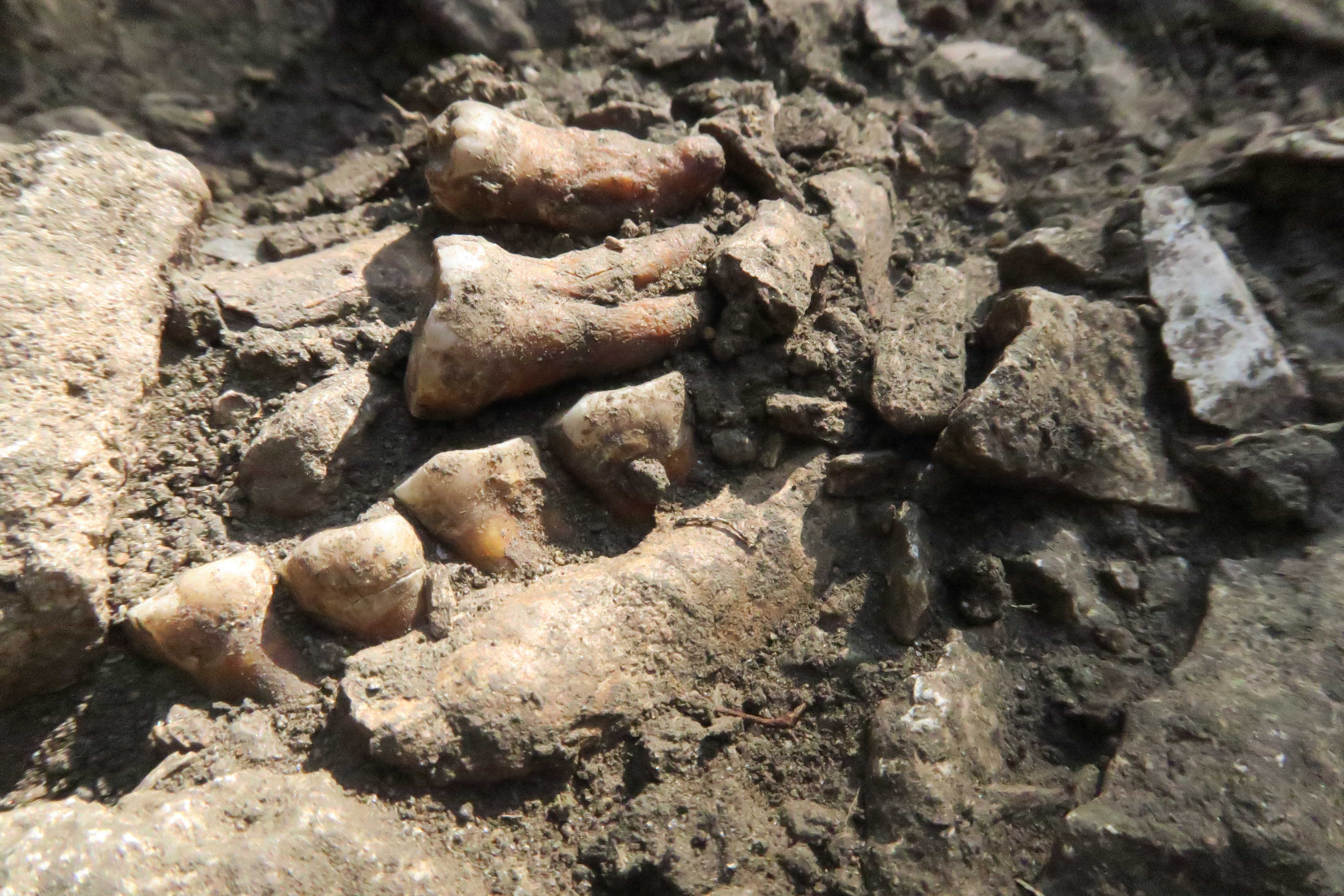Genetics
Scientists Unlock the Secrets of Crocodile Skin and Its Irregular, Mystifying Patterns
The scales on crocodiles’ heads are very different from the skin appendages of other animals and even distinct from the scales on the rest of their bodies
Geneticists Solve the Mystery of Why Some Cats Are Orange—and Why They Tend to Be Males
Two new, preliminary papers identify a gene related to a cat’s coloration. The work also explains why tortoiseshell and calico cats tend to be females
Fat Cells Retain a 'Memory' of Obesity, Making It Hard to Lose Weight and Keep It Off, Study Suggests
Obesity leads to DNA alterations that affect gene activity and linger after weight loss, a finding that researchers say could help reduce stigma around the disease
DNA Evidence Is Rewriting the Stories of Victims Who Perished in Pompeii Nearly 2,000 Years Ago
A new study has shattered historians' long-held assumptions about some of the people who died in Mount Vesuvius' eruption in 79 C.E.
A Simple Chemical Shift Explains Why Parrots Are So Colorful, Study Suggests
Unlike other birds, which get pigments from their diets, parrots produce their own—but scientists never fully understood the underlying mechanisms, until now
Scientists Think a Skeleton Found in a Well Is the Same Man Described in an 800-Year-Old Norse Text
The remains were discovered during excavations in 1938. Now, researchers have learned new information about his identity by analyzing DNA from his tooth
A 110-Year-Old Pickled Thylacine Head Helped Build the Most Complete Ancient Genome to Date, Says 'De-Extinction' Company
Colossal Biosciences reports it extracted DNA and RNA from the Tasmanian tiger specimen, a key step forward in its effort to create a modern proxy of the extinct species. Other scientists are calling for data to back up the claim
An Ice Age Infant’s 17,000-Year-Old DNA Reveals He Had Dark Skin and Blue Eyes
The baby boy’s recovered genome suggests he’s related to a famous Ice Age population
Can't Get Enough Carbs? That Craving Might Have Started More Than 800,000 Years Ago
New research traces the genetic underpinnings of the enzyme amylase, which helps humans digest starches and sugars
Could Anyone Bring an Extinct Animal Back to Life? And More Questions From Our Readers
You’ve got questions. We’ve got experts
Two Lions Went on a Man-Eating Spree in 1898. Now, DNA Evidence Reveals Their Diets
The notorious predators, nicknamed the “Man-Eaters of Tsavo,” terrorized railway workers in Kenya for roughly nine months
From Silk Moths to Fruit Flies, These Five Insects Have Changed the World
It’s easy to write bugs off as pests, but consider the ways in which they have positively impacted our lives
American Scientists Win Nobel Prize in Medicine for 'Groundbreaking' Gene Discovery Made by Studying Worms
Victor Ambros and Gary Ruvkun discovered microRNA, tiny molecules that play a crucial role in how cells develop, paving the way for new treatments for diseases
Scientists Unveil the First-Ever Complete Map of an Adult Fruit Fly's Brain, Captured in Stunning Detail
The brain diagram, called a connectome, could revolutionize researchers' understanding of the human brain, which has many parallels with a fruit fly's
Montana Rancher Who Created Giant, Hybrid Sheep Sentenced to Six Months in Prison
Arthur “Jack” Schubarth cloned illegally imported genetic material from the Marco Polo argali to create hybrid sheep that would draw higher prices from hunting preserves
Breast Cancer Cases Are Rising Among Younger Women, Report Finds
Though breast cancer mortality is declining overall, Asian American women and women under 50 have experienced an uptick in diagnoses of the disease
In Case Humans Go Extinct, This Memory Crystal Will Store Our Genome for Billions of Years
Scientists have created "a form of information immortality" meant to instruct future species on how to recreate humans. But who, or what, will find it?
Easter Island's Ancient Population Never Faced Ecological Collapse, Suggests Another Study
New DNA analysis adds to growing research indicating the famous Pacific island did not collapse from overuse of resources before the arrival of Europeans
Ancient DNA Reveals Neanderthal Group Was Isolated for 50,000 Years
A new study, based on the remains of a Neanderthal nicknamed Thorin, is shaking up what archaeologists long thought about these early humans in Europe
Scientists Identify the Gene Behind Thorny Roses and Other Prickly Plants
A recent study could pave the way to cultivating various thornless plants, making them easier to grow and potentially more widely available
Page 1 of 32
:focal(249x297:250x298)/https://tf-cmsv2-smithsonianmag-media.s3.amazonaws.com/filer_public/82/2d/822df92e-385b-4b0e-a4c8-9a48b1b4816e/1024px-nile_crocodile_head.jpg)
:focal(2736x1733:2737x1734)/https://tf-cmsv2-smithsonianmag-media.s3.amazonaws.com/filer_public/8c/67/8c67a0ce-babb-4d7d-97c3-dd4abcfcc51c/gettyimages-1190651900.jpg)
:focal(2422x2053:2423x2054)/https://tf-cmsv2-smithsonianmag-media.s3.amazonaws.com/filer_public/b0/84/b0842710-0364-4fea-af8f-d9b2ebb10697/gettyimages-549602961.jpg)
:focal(848x638:849x639)/https://tf-cmsv2-smithsonianmag-media.s3.amazonaws.com/filer_public/15/b6/15b62b35-b360-4b81-8019-ef6aed2fece2/original_1.jpeg)
:focal(512x341:513x342)/https://tf-cmsv2-smithsonianmag-media.s3.amazonaws.com/filer_public/42/40/4240df25-5b50-4250-b4d4-6765cf334159/1024px-dusky_lories_-_woburn_safari_park_4558929462.jpg)
:focal(450x338:451x339)/https://tf-cmsv2-smithsonianmag-media.s3.amazonaws.com/filer_public/8c/09/8c09444b-5a9b-424a-b5bf-4e47be6742ad/gr1_lrg.jpeg)
:focal(191x115:192x116)/https://tf-cmsv2-smithsonianmag-media.s3.amazonaws.com/filer_public/4d/68/4d68d031-9cdf-425a-a66e-32d1834b07db/thylacinus_cynocephalus_2_gould.jpg)
:focal(847x637:848x638)/https://tf-cmsv2-smithsonianmag-media.s3.amazonaws.com/filer_public/49/a0/49a04cd4-ff2c-4863-abf0-ddab5e58b61d/screen_shot_2024-10-21_at_114341_am.jpeg)
:focal(960x640:961x641)/https://tf-cmsv2-smithsonianmag-media.s3.amazonaws.com/filer_public/9e/59/9e592cb6-c1d1-4bb4-ae6e-d9bacbff09b4/bread-8503298_1920.jpg)
:focal(732x551:733x552)/https://tf-cmsv2-smithsonianmag-media.s3.amazonaws.com/filer_public/f5/61/f561cab7-4fb7-4041-a2c2-88d65608bfd0/ask.jpg)
:focal(351x234:352x235)/https://tf-cmsv2-smithsonianmag-media.s3.amazonaws.com/filer_public/fc/91/fc912dea-5c42-4fd3-90b5-1b9d2081134f/lionsoftsavo2008.jpg)
:focal(1009x745:1010x746)/https://tf-cmsv2-smithsonianmag-media.s3.amazonaws.com/filer_public/8e/88/8e88895c-c55b-4a1c-8419-95a9ec25b4bf/gettyimages-987257254.jpg)
:focal(3402x2268:3403x2269)/https://tf-cmsv2-smithsonianmag-media.s3.amazonaws.com/filer_public/27/85/278532d8-0090-42d6-9ff6-77449b49da84/gettyimages-2176426457.jpg)
:focal(1440x960:1441x961)/https://tf-cmsv2-smithsonianmag-media.s3.amazonaws.com/filer_public/b1/25/b12582c3-4fdf-4447-9938-41a2fb15bb60/fw_all_l.png)
:focal(1024x683:1025x684)/https://tf-cmsv2-smithsonianmag-media.s3.amazonaws.com/filer_public/d1/51/d151d4a5-2747-41a7-8079-14ef0a402d1c/6036855262_5e539058f1_k.jpg)
:focal(1060x717:1061x718)/https://tf-cmsv2-smithsonianmag-media.s3.amazonaws.com/filer_public/58/6b/586bf226-844c-41e0-a28f-be9217d380f6/gettyimages-2147721996.jpg)
:focal(1024x575:1025x576)/https://tf-cmsv2-smithsonianmag-media.s3.amazonaws.com/filer_public/5a/e2/5ae236c1-dbe7-48a0-9b08-03e71a9e2590/skynews-genome-5d-crystal_6689808.jpg)
:focal(1200x800:1201x801)/https://tf-cmsv2-smithsonianmag-media.s3.amazonaws.com/filer_public/58/d8/58d86da0-cbee-4298-9a13-039bea8d2ae3/thomas-griggs-anvaqssbtms-unsplash.jpg)

:focal(2128x1419:2129x1420)/https://tf-cmsv2-smithsonianmag-media.s3.amazonaws.com/filer_public/25/28/2528f427-5b55-4e98-b85e-5f9523b4fc9a/gettyimages-157567545.jpg)